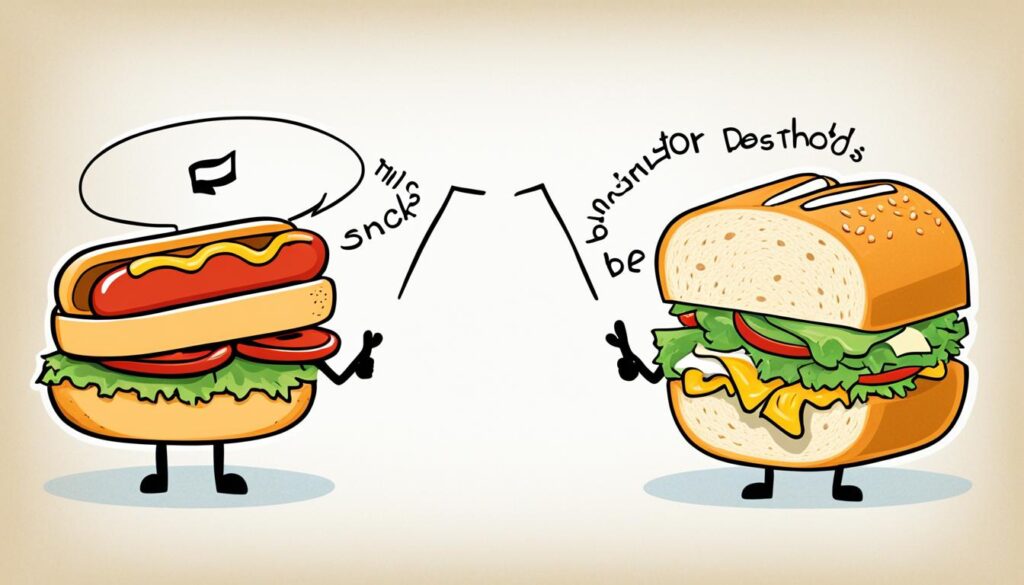The question of whether a hotdog can be classified as a sandwich has sparked heated debates and discussions across the internet. Even language experts from Merriam-Webster have weighed in, stating that a hotdog can indeed be considered a sandwich based on the definition of “two or more slices of bread or a split roll having a filling in between.” Despite this verdict, the debate continues to rage on, with search queries on this topic reaching new peaks in recent years.
Key Takeaways:
- A hotdog being classified as a sandwich has been a controversial topic debated among food enthusiasts.
- Language experts from Merriam-Webster argue that a hotdog meets the criteria of a sandwich based on its structure.
- The debate over whether a hotdog is a sandwich or not continues to generate interest and discussion online.
- Personal interpretations and perceptions play a significant role in shaping one’s viewpoint on hotdogs as sandwiches.
- While there is no unanimous consensus, the debate fuels curiosity and intrigue within the culinary world.
The Verdict from Experts and the Internet
Notable figures such as the late Ruth Bader Ginsburg and culinary icon Padma Lakshmi have chimed in on the hotdog sandwich debate. Ruth Bader Ginsburg declared on The Late Show With Stephen Colbert that a hotdog is indeed a sandwich. Likewise, Padma Lakshmi, during an appearance on The Tonight Show Starring Jimmy Fallon, stated that while a hotdog may be a poor excuse for a sandwich, it technically falls into the sandwich category. These viewpoints have fueled the ongoing discussion on social media platforms and online forums.
The debate surrounding the classification of hotdogs as sandwiches has garnered attention from experts and the general public alike. The perspectives of well-known individuals like Ruth Bader Ginsburg and Padma Lakshmi have contributed to the discourse and generated further interest in this culinary controversy.
Now is a good time to explore the various viewpoints and arguments surrounding the hotdog sandwich debate. By examining the opinions of both experts and the internet, we can gain a comprehensive understanding of this fascinating topic.
While Ruth Bader Ginsburg firmly stated that a hotdog is indeed a sandwich, Padma Lakshmi expressed a more nuanced opinion, acknowledging that a hotdog can be classified as a sandwich from a technical standpoint. These divergent perspectives have sparked discussions on social media platforms and online forums, with individuals presenting their own thoughts and interpretations.
Through these conversations, we can delve into the intricacies of sandwich theory and explore the multifaceted nature of the hotdog classification debate. Whether a hotdog is considered a sandwich or not, the arguments and viewpoints surrounding this topic are a testament to the passion and interest it evokes among food enthusiasts.
Insight from In-Context Research
In an effort to gain a deeper understanding of the hotdog sandwich debate, research was conducted through the dscout app, where nearly 600 people responded with their opinions in less than 48 hours. The results showed that 61% of respondents believed that a hotdog is not a sandwich, while 39% considered it to be one. This data highlighted the generational divide, with 67% of retirees considering a hotdog to be a sandwich compared to 63% of students who did not. The research also revealed that location played a role, with 72% of Illinois residents believing a hotdog is not a sandwich compared to 55% of California residents.
| Demographic | Percentage believing hotdog is a sandwich | Percentage believing hotdog is not a sandwich |
|---|---|---|
| Retirees | 67% | 33% |
| Students | 37% | 63% |
| Illinois residents | 28% | 72% |
| California residents | 45% | 55% |
This in-context research provided valuable insights into the perspectives of different demographics and regions. The findings suggest that opinions on the hotdog sandwich classification vary based on factors such as age and location. These variations contribute to the ongoing discussion and highlight the complexity of the food speculation surrounding hotdogs.
Structure and Perception
The structure of a hotdog has been a crucial aspect in the ongoing debate surrounding its classification. Many individuals argue that the connected bun and the cylindrical shape of the meat set it apart from traditional sandwiches. In a recent research study, participants drew comparisons between hotdogs and tacos, highlighting the distinct differences between franks and hamburgers.
For both sides of the debate, the form factor of a hotdog plays a significant role. In fact, 65% of respondents in the study cited the bread and meat arrangement as the primary reason for considering or not considering a hotdog as a sandwich.
To illustrate the discussion more clearly, let’s compare the structure of a hotdog to that of a traditional sandwich:
| Hotdog | Sandwich |
|---|---|
| Bun connected along one side | Two separate slices of bread |
| Cylindrical-shaped meat | Various fillings (meat, cheese, vegetables, etc.) |
| Sometimes additional condiments inside, such as mustard or relish | Condiments can be added between the bread slices |
Based on this comparison, it becomes evident that the structure of a hotdog differs in key ways from a traditional sandwich, supporting arguments that place hotdogs in a separate culinary category.

The Role of Condiments and Context
When it comes to the hotdog classification debate, one crucial aspect that sets hotdogs apart from traditional sandwiches is the role of condiments. The “open-air” structure of a hotdog allows for the inclusion of specific toppings that are not typically found on sandwiches, such as chili, sauerkraut, and ketchup. These condiments enhance the flavor and add an extra dimension to the hotdog eating experience.
Moreover, the research study conducted on hotdog classification revealed an interesting insight regarding the social aspect of consuming hotdogs. It was found that 61% of hotdogs were enjoyed in the company of others, compared to 38% of sandwiches. The perception of hotdogs as a celebratory and sociable food contributes to the resistance in categorizing them as sandwiches.
The presence of condiments and the context in which hotdogs are consumed play significant roles in differentiating them from sandwiches. The ability to customize a hotdog with unique toppings and the social enjoyment that accompanies it contribute to the controversy surrounding its classification as a sandwich.
Different Perspectives from Culinary Experts
Culinary experts and representatives from iconic hotdog restaurants and sausage companies have weighed in on the hotdog sandwich debate, offering unique insights and perspectives. These viewpoints contribute to the ongoing culinary classification controversy and shed light on the distinct characteristics of hotdogs.
- The National Hot Dog and Sausage Council insists on separating hotdogs from sandwiches. According to their viewpoint, referring to a hotdog as “just a sandwich” undermines its significance as a culinary creation.
- Phil McCann, the vice president of marketing at Nathan’s Famous, believes that hotdogs deserve their own category, similar to burgers. His perspective emphasizes the individuality and distinctiveness of hotdogs.
These differing opinions highlight the food controversy surrounding the hotdog’s classification. While some argue for its inclusion in the sandwich category, others advocate for recognizing hotdogs as a unique entity within the culinary world. Understanding these perspectives is vital in comprehending the intricacies of the ongoing debate.
Table: A Comparison of Culinary Expert Perspectives on Hotdog Classification
| Expert | Viewpoint |
|---|---|
| The National Hot Dog and Sausage Council | Hotdogs should be distinguished from sandwiches |
| Phil McCann, Vice President of Marketing at Nathan’s Famous | Hotdogs deserve their own culinary category |
A Broad Definition of Sandwiches
The definition of a sandwich typically includes two pieces of bread with meat, cheese, or other fillings between them. Taking this definition into consideration, a hotdog bun can be considered as two pieces of bread, making the hotdog fit the description of a sandwich. Some experts argue that while a hotdog may not meet all the traditional criteria of a sandwich, it falls under the broader category of sandwiches. The debate over the classification of hotdogs as sandwiches continues to generate passionate arguments on both sides.
Conclusion
The hotdog sandwich debate has stirred up passionate discussions and divided opinions among experts and the general public. Despite the input from language experts and culinary icons, a unanimous consensus on the classification of hotdogs as sandwiches remains elusive. The structure, condiments, geographical location, and individual perspectives all contribute to shaping people’s viewpoints on this culinary conundrum.
When examining the structure of hotdogs, the connected bun and cylindrical-shaped meat differentiate them from traditional sandwiches, leading some to argue against their classification as sandwiches. Furthermore, the key role of condiments in the hotdog experience sets them apart from typical sandwich fillings and adds to the debate.
Research insights highlight generational and regional differences in opinions, indicating that personal interpretations of what constitutes a sandwich heavily influence the ongoing discussion. Ultimately, whether a hotdog is deemed a sandwich or not is a matter of personal perception and individual interpretation.
As the hotdog sandwich debate rages on, it continues to captivate both online communities and culinary experts. With no definitive resolution in sight, this controversial topic is destined to remain a topic of conversation and contention for food enthusiasts and curious minds alike.
FAQ
Is a hotdog a sandwich?
The classification of a hotdog as a sandwich has been a subject of debate and speculation. While some argue that a hotdog meets the definition of a sandwich, others believe it has unique characteristics that set it apart.
What do experts and the internet say about the hotdog sandwich debate?
Experts, including language experts and culinary icons, have shared their perspectives on whether a hotdog can be classified as a sandwich. The verdict is divided, with some stating that a hotdog fits the definition of a sandwich, while others argue that it falls into its own category.
What insights were gained from in-context research on the hotdog sandwich debate?
In a research study involving nearly 600 respondents, it was found that the majority believed a hotdog is not a sandwich. The study also revealed generational and regional differences in opinions on the classification of hotdogs.
How does the structure and perception of hotdogs impact their classification?
The connected bun and cylindrical shape of a hotdog have been points of contention in the debate. Some argue that these attributes differentiate hotdogs from traditional sandwiches, while others compare them to tacos or hamburgers.
What role do condiments and context play in the hotdog sandwich debate?
The ability to add specific condiments and the social aspect of consuming hotdogs have been cited as factors that set them apart from sandwiches. The inclusion of condiments not typically found on sandwiches and the perception of hotdogs as celebratory and social foods contribute to the reluctance to classify them as sandwiches.
What perspectives do culinary experts offer on the hotdog sandwich debate?
Culinary experts and representatives from iconic hotdog restaurants and sausage companies have expressed differing opinions. Some argue that hotdogs should not be referred to as sandwiches, emphasizing their distinct characteristics.
How does the definition of sandwiches factor into the hotdog classification debate?
While a hotdog may not meet all the traditional criteria of a sandwich, some argue that it falls under the broader category of sandwiches. The definition of a sandwich typically includes two pieces of bread with a filling, which can include a hotdog bun.







